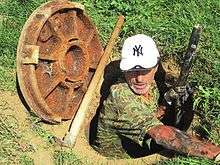Manhole




A manhole (alternatively utility hole, cable chamber, maintenance hole, inspection chamber, access chamber, sewer hole, or confined space) is the top opening to an underground utility vault used to house an access point for making connections, inspection, valve adjustments or performing maintenance on underground and buried public utility and other services including water, sewers, telephone, electricity, storm drains, district heating and gas.
Usage
Manhole closings are protected by a manhole cover, a flat plug designed to prevent accidental or unauthorized access to the manhole. Those plugs are traditionally made of metal, but may be constructed from precast concrete, glass reinforced plastic or other composite material (especially in Europe, or where cover theft is of concern).
Manholes are usually outfitted with metal, polypropylene, or fiberglass steps installed in the inner side of the wall to allow easy descent into the utility space. Because of legislation restricting acceptable manual handling weights, Europe has seen a move toward lighter weight composite manhole cover materials, which also have the benefits of greater slip resistance and electrical insulating properties.
The access openings are usually circular in shape to prevent accidental fall of the cover into the hole.
Manholes are generally found in urban areas, in streets and occasionally under sidewalks. In rural and undeveloped areas, services such as telephone and electricity are usually carried on utility poles or even pylons rather than underground.
Composite manholes
Composite (fiberglass) manholes are commonly used in applications where infiltration, exfiltration, or corrosion by hydrogen sulfide (from sewer gas) are a concern, or where structures need to be factory integrated into a manhole before placement.
Structures commonly integrated into composite manholes include:
- Flow inverts[1]
- Flumes[2]
- Drop structures from higher elevation flows to lower elevation discharge pipes
Occasionally, composite manholes will integrate:
- Weirs[3]
- Storm water screening structures[4]
- Sewage grinders[5]
- Energy absorbing structures to dissipate undesirable flow stream turbulence or velocity[6]
Hazards caused by stray voltage in manholes
In urban areas, stray voltage issues have become a significant concern for utilities. In 2004, Jodie S. Lane was electrocuted after stepping on a metal manhole cover, while walking her dog in New York City.[7]
See also
Notes
- ↑ "Manhole inverts" (PDF). Containment Solutions.
- ↑ "Packaged Fiberglass (FRP) Flume Manholes". Openchannelflow.
- ↑ "Packaged Fiberglass (FRP) Weir Manholes for Flow Monitoring". Openchannelflow.
- ↑ "Fiberglass (FRP) Storm Water Manholes for Initial Oil, Grease, Sediment, and Debris Collection". Openchannelflow.
- ↑ "Fiberglass (FRP) Grinder Manholes integrating grinders from JWC, Franklin Miller, MonoFlo, and more". Openchannelflow.
- ↑ "Fiberglass Energy Absorbing Manholes for Controlling Excess Line Velocities". Openchannelflow.
- ↑ Ramirez, Anthony (January 19, 2004). "East Village Woman Was Electrocuted on Street With Metal Plate, Medical Examiner Says". New York Times. Retrieved 2009-12-03.
References
- Isles, Paul (2010). "Dover Engineering Works". Dover Life Magazine
Further reading
- Ascher, Kate ; researched by Wendy Marech (2007). The works : anatomy of a city (Reprint. ed.). New York: Penguin Press. ISBN 978-0-14-311270-9.
| Wikimedia Commons has media related to Manholes. |